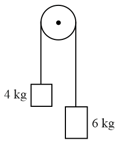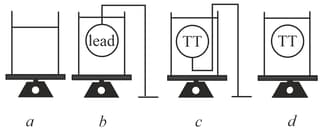A helicopter of mass rises with a vertical upwards with an acceleration of . The total mass of the crew and passengers is . Which among the following are correct?
( Take )
(i) The force on the floor of the helicopter by the crew and passengers is vertically downward direction.
(ii) The action of the rotor of the helicopter on the surrounding air is in the vertically downward direction.
(iii) The force on the helicopter due to the surrounding air is vertically upward direction.
(i) The force on the floor of the helicopter by the crew and passengers is vertically downward direction.
(ii) The action of the rotor of the helicopter on the surrounding air is in the vertically downward direction.
(iii) The force on the helicopter due to the surrounding air is vertically upward direction.
Important Questions on Laws of Motion

A spherical body of mass starting from rest acquires a kinetic energy of at the end of second. The force acted on the body is _____ .
Four identical beakers contain same amount of water as shown below.

Beaker contains only water. A lead ball is held submerged in the beaker by string from above. A same sized plastic ball, say a table tennis ball, is held submerged in beaker by a string attached to a stand from outside. Beaker contains same sized ball which is held submerged from a string attached to the bottom of the beaker. These beakers (without stand) are placed on weighing pans and register readings and for and respectively. Effects of the mass and volume of the stand and string are to be neglected.
Calculate the acceleration of the block and trolly system shown in the figure. The coefficient of kinetic friction between the trolly and the surface is ( mass of the string is negligible and no other friction exists).

A block of mass rests on another block of mass and is tied to a wall as shown in the figure. The coefficient of friction between and is and that between and ground is . The minimum force required to move the block is


